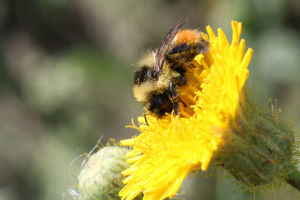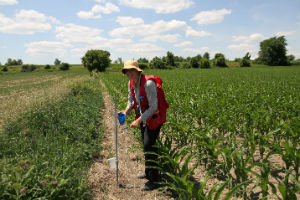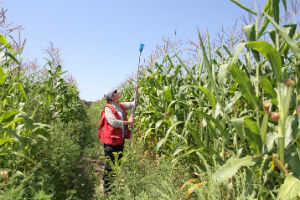Dr. Ilona Naujokatitis-Lewis, a landscape ecologist at Environment and Climate Change Canada, spent the summer of 2016 in the field, literally. She was looking for native bee species in farmland south of Ottawa to almost the St. Lawrence Seaway, to find out what was causing declines in these essential pollinators.
Collaboration is a key to the Government of Canada’s science, and in examining ecosystem health and developing approaches to integrated ecosystem management and resilience.
Dr. Naujokatitis-Lewis’s collaboration started well before she and her colleague entomologist Dr. Sophie Cardinal from Agriculture and Agri-Foods Canada took samples of flowers, vegetation, and bees from 30 different landscapes.
Over the course of their two-year study, they want to get more information on the impact of habitat loss and global threats, such as climate change, on the native bee population.
The scopa or hairs on bees which collect pollen are seen clearly here in a photo by Dr. Ilona Naujokatitis-Lewis.
The sites they visited in 2016 were a subset of sites that were sampled in 2011. Collecting data over multiple years allows scientists to find out which species are present in a certain area, and get a clearer picture of why population species numbers change over time.
Before they could even set foot on the fields, windbreaks, and hedgerows of their study area, they needed permission from landowners, and they needed the proper equipment to take bee samples.
Dr. Ilona Naujokatitis-Lewis needed adjustable PVC pan traps to be able to sample fields of corn and soybeans, so she modified them herself. Corn is pollinated by the wind, and while soybeans were generally thought to be self-pollinated, recent research suggests that bees might improve soybean yields. Different bee species are attracted to different colours, this is why Dr. Naujokatitis-Lewis used yellow, white and blue cups.
Dr. Naujokatitis-Lewis visits a corn field in June 2016
For two weeks in June, and two weeks in August 2016, two crews of field technicians and scientists met at 6:30 a.m. the National Wildlife Research Centre to gather equipment for the day.
When Dr. Naujokatitis-Lewis adjusted her pan trap at a corn field in August 2016, it was about six or eight feet high.
“It was a hot and dry growing season with severe drought conditions,” said Dr. Naujokatitis-Lewis. “This shows how important it is to collect data over period of time. Without knowing what was here before, it can be really challenging to know how species are responding over time to both land-use and climate changes.”
The bees are now being identified in Dr. Cardinal’s lab at Agriculture and Agri-Foods Canada.
“We’ve identified 10 different species of bumble bees in the samples collected, and we’re in the process of identifying all of the other kinds of bees to species,” said Dr. Cardinal. There are over 800 species of bees in Canada.
The data collected will be analyzed in the coming months. Dr. Naujokatitis-Lewis will share data and results of her study with farmers involved in the study and with Canadians more broadly through publications and open data.
One of the research assistants from Carleton University, Tonya Tanner, updated her landscape data from her Master’s thesis and found many field sizes increasing. Farmers were removing the linear features (windbreaks and hedgerows) which provide important habitat for pollinators.
“It shows how quickly the landscape can change. These types of changes are occurring rapidly across agricultural landscapes. In combination with other practices, these can affect native bees especially when nesting and foraging habitats become scarce,” said Dr. Naujokatitis-Lewis.
Protecting Canada’s natural environment from the impacts of stressors on the environment is a key part of Environment and Climate Change Canada’s science work. “A healthy bee population improves crop outcomes for farmers,” she said. “They are indicators of healthy ecosystem services, and have value as being part of biodiversity.”



